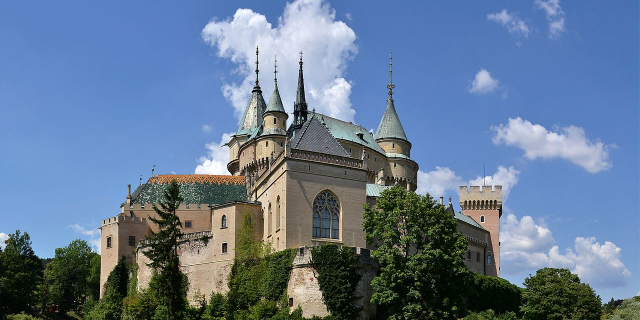Banská Štiavnica (Slovak pronunciation: [ˈbanskaː ˈʂcɪɐʋɲitsa] ; German: Schemnitz; Hungarian: Selmecbánya (Selmec), pronounced [ˈʃɛlmɛd͡zbaːɲɒ]) is a town in central Slovakia, in the middle of an immense caldera created by the collapse of an ancient volcano. For its size, the caldera is known as the Štiavnica Mountains. Banská Štiavnica has a population of more than 10,000. It is a completely preserved medieval town. Because of their historical value, the town and its surroundings were proclaimed by the UNESCO to be a World Heritage Site on December 11, 1993.
The fate of Banská Štiavnica has been closely linked to the exploitation of its abundant resources of silver ore. According to evidence from excavations, the site was settled during the Neolithic period.
The first mining settlement was founded by Celts in the 3rd century BC. It was probably occupied by the Celtic Cotini tribe. Roman authors mentioned mining activities of the Cotini, who had lived in present-day central Slovakia until they were deported to Pannonia within the Marcomannic Wars by Rome. The site was also settled by early Hungarians and an old Hungarian fortified settlement was situated here in the 10th and 11th century. The site was called “terra banensium” (the land of miners) as early as 1156. The local Slavic population gave the name „Štiavnica“ (acidic stream) to the settlement in the valley, and the settlement on the hill above (Ligotavá hora, or Glanzenberg – the shiny mountain) came to be called „Bánya“ (the mine). The single common name „Schebnyzbana“ was documented for the first time in 1255.[1] The local Slavic population was joined by skilled German settlers who started arriving in the 13th century. They adapted the local name to the German "Schemnitz". Banská Štiavnica gained the status of a royal town in 1238, as one of the first towns in the Kingdom of Hungary.
In the High and Late Middle Ages, the town was the main producer of silver and gold in the Kingdom of Hungary. During the Ottoman Wars, the Turks made concerted efforts to conquer rich mining towns in Upper Hungary (Banská Štiavnica, Banská Bystrica, and Kremnica). This new threat led Banská Štiavnica to build powerful fortifications, including two castles, in the 16th century. As one of the most important centers of the Protestant Reformation in the country, the town belonged to the Protestant "League of Seven Mining Towns" together with Banská Belá, Banská Bystrica, Kremnica, Ľubietová, Nová Baňa, and Pukanec.
 School buildings in Banská Štiavnica, end of 19th – early 20th century
School buildings in Banská Štiavnica, end of 19th – early 20th century Academy of Mining and Forestry memorial plaque
Academy of Mining and Forestry memorial plaqueThe town was also a leading center of innovation in the mining industry. In 1627, gunpowder was used there in a mine for one of the first times in the world (After Le Thillot, France). To drain water from the flooded mines, a sophisticated system of water reservoirs and channels, known as tajchy, was designed and built by the local scientists Jozef Karol Hell, Maximilian Hell, and Samuel Mikovíny in the 18th century. Tajchy not only saved the mines from being closed, but also provided energy for the early phase of industrialization.
Its Mining Academy, founded there in 1735 by Samuel Mikovíny, was the first mining school in the Kingdom of Hungary. Beginning in 1763, the Hofkammer in Vienna, with support from Queen Maria Theresa, transformed the school into the Academy of Mining.[2] In 1807, a Forestry Institute was "established under the decision of Emperor Franz I"; in 1848 the school was renamed the Academy of Mining and Forestry, 'the first technical university in the world'.[3] In 1919, after the creation of Czechoslovakia, the Academy was moved to Sopron in Hungary. The student traditions of the Academy (School traditions of Selmec) are still living in its successors, the University of Miskolc and Slovak University of Technology in Bratislava,[4] and colleges in Sopron, Székesfehérvár, and Dunaújváros.[citation needed]
In 1782, Banská Štiavnica was the third biggest town in the Kingdom of Hungary (with 23,192 or incl. suburbs 40,000 inhabitants), after Pozsony (today Bratislava) and Debrecen. But the town's development was too closely linked to the mining activity which had been progressively declining since the second half of the 19th century. Nowadays, Banská Štiavnica is an important center of recreation and tourism, benefiting from its rich historical heritage.
During World War II, Banská Štiavnica was taken by Soviet troops of the 53rd Army on 7 March 1945.[5]































Add new comment